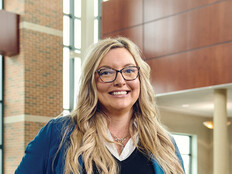By quickly screening an incoming employee or visitor for elevated body temperature — a common but not definitive symptom of COVID-19 — staff can deny that person entry to help prevent unintentional spread of the disease.
Infrared technology often calibrates against a “black body” accessory to indicate the difference between a subject’s temperature and the black body’s predetermined temperature. Some setups use multiple pieces of equipment; others are all-in-one touchless kiosks that print a wearable sticker after a reading is taken to confirm an individual is approved to enter.
Although the pandemic has prompted more providers to discover and deploy these tools, they can serve a broader long-term purpose during periods such as flu season.
“This is not a COVID-19 strategy; this is an infection control strategy,” Jim Dellapa, CIO of the Piscataway, N.J.-based aging services organization Parker Life, told LeadingAge audiences Wednesday.
Temperature Screening Tech Supports Efficiency and Data Collection
At the start of the pandemic, employees at Cypress Living in Fort Myers, Fla., were stationed at the entrance to take readings with a manual thermometer and record the details on paper (they later moved to using Office 365 and iPad devices).
The assisted living and memory care community, located on a peninsula, ultimately set up a thermal camera system at a single point of entry.
“We set up our screening checkpoint at that one location that allowed us to control where people got screened, which was a huge benefit,” Joe Velderman, the organization’s vice president of innovation, told LeadingAge attendees. “An automated solution brought more efficiency and more data collection into the process.”
READ MORE: Learn how hospitals have deployed thermal cameras to protect patients and staff.
Not only can the thermal imaging system quicky report the temperature of a Cypress Living staffer, it can record and transmit that information so employees or inspectors can search records by name, time or date to assist with contact tracing.
Still, thermal cameras shouldn’t be used as a catchall, LeadingAge panelists stressed.
“Infrared temperature scanning is not a silver bullet,” Velderman said, noting frequent COVID-19 testing for employees is the best line of defense. “We have had plenty of staff members test positive for COVID without having a single symptom.”
A person who has been out in the sun, on the other hand, may need to cool down and be screened again.
Best Practices for Using Thermal Cameras in Senior Care Communities
Setting up a thermal screening system requires planning, speakers told LeadingAge audiences.
Senior care teams must be diligent when vetting potential vendors. “The market has been flooded with these systems,” said Dellapa, who emphasized the tools should be a “core competency” for any technology provider being considered.
Cypress Living staff tested one infrared solution against manual thermometers on incoming guests before moving forward with the purchase, Velderman said.













